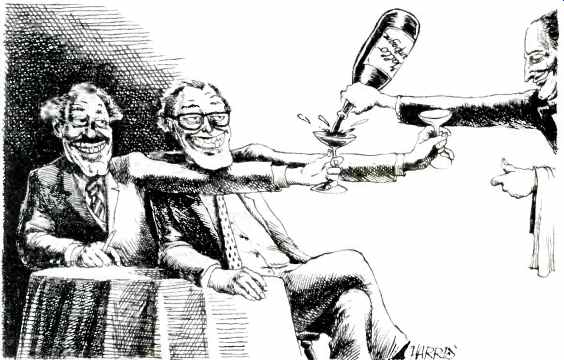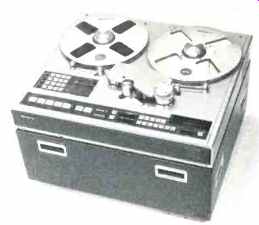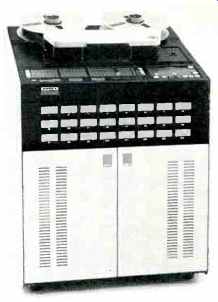
Recessionary influences notwithstanding, the Audio Engineering Society held
its 64th Convention, November 2 to 5, amid the somewhat faded splendors of
the Waldorf Astoria in New York. Although rated as "the biggest AES Convention
ever," there is no doubt that the present economic uncertainties are being
closely monitored by many manufacturers. Let us say that the audio industry
is sipping champagne, but it is of the domestic variety, not vintage French!
As you might expect, digital recording technology still holds the spotlight
as the major topic of interest. 3M, which has been offering its 32-channel
pre-mix digital recorder and 4-channel master recorder on a lease basis, is
now making these units available on a direct sale basis. The 32-channel unit
is priced at $115,000 and the 4-channel master recorder at $35,000. At the
Convention, 3M introduced a 16-channel pre-mix digital recorder at $72,500,
and a 16-channel update kit (to convert the 16-channel recorder to 32 channels)
for $53,200. These new digital recorders are said to be available for immediate
delivery. Also new from 3M were two digital-delay preview units for disc-cutting,
a 1.3-second preview unit for $5,500, and a 1.96-second-delay preview unit
for $7,400. The electronic editing system introduced at the 63rd AES Convention
is priced at $7,500 and has recently been made available.
Much interest was shown in the new Mitsubishi X-80 digital recorder.
This is a two-channel stereo recorder i using quarter-inch tape at a speed of 15 ips. Its stationary head unit affords one hour of recording on a 10 1/2-inch reel. The X-80 is a relatively light and transportable 143 pounds, lending itself to location recording. The unit uses 16-bit linear encoding with a sampling frequency of 50.35 kHz. The PCM signal is subjected to modified frequency modulation and is distributed among eight tracks on the quarter inch tape, with a high recording density of 797 bit/mm. One auxiliary analog track and one SMPTE code address track are provided outside the digital tracks. The analog track permits normal tape-cut editing, with special circuitry allowing continuous phase-lock control across the splice point. The SMPTE code track allows electronic editing. Drop-out error correction is via cyclic redundancy check code, with interleaving and interpolation.
Click-noise generation incidence is said to be extremely small. Frequency response is claimed to be within x-0.3 dB from 20 Hz to 20 kHz, while the dynamic range is said to be over 90 dB, with less than '0.02 percent distortion at peak levels. To make their digital recording system complete, Mitsubishi also offers the XE-1 electronic editor and a disc-cutter preview unit with delay times adjustable from 0.8 to 1.8 seconds. What caused quite a stir among the smaller independent recording companies were the Mitsubishi prices "around $20,000" for the X-80 digital recorder, with the electronic editor at $8,000, and the disc-cutter delay unit at $7,000. In other words, for around $55,000 you get two X-80 recorders (one for recording, one for editing layout), the editor, and preview unit. This presently makes the Mitsubishi digital system the least expensive entry into digital recording.
Several from Sony
Sony continues to concentrate on digital recording technology. In fact, they now bill themselves as the "world's largest producer of digital recording equipment." Their exhibit in the ballroom of the Waldorf was almost entirely devoted to digital units, and they introduced a number of new products. Of prime interest was the PCM-3324 digital recorder. The system consists of a 24-channel transport with fixed heads, using half-inch video tape at 30 ips, with a separate rack mount for the digital audio processor. At 30 ips, this machine can record for 60 minutes on a 14-inch reel of Sony V-16 video tape. The recorder uses 16-bit linear encoding and has the facility of switchable sampling frequencies of 32 ' (some Europeans favor this), 44.056 (EIAJ standard), 44.1, 48, 50.0, 50.35, and 50.7 kHz. The track format is two digital tracks per channel, one track for SMPTE time code, and two tracks for analog audio. The analog tracks permit normal tape-cut editing, while the SMPTE track affords electronic editing and multi-deck synchronization.
Punch in/out recording is also provided. There are analog as well as digital input/output connections for interfacing with existing analog and new generation digital studio systems. Sony has a new correcting code and modified cross-word error-correcting system in this unit. With the data blocks incorporating internal as well as external error-checking, there is a total of 41.7 percent redundancy for synchronization and correction. Sony claims this new PCM-3324 recorder affords digital-to-digital duplication with no signal quality deterioration.
While the Sony 1600 PCM with UMatic VTR is now on the market and has been used for digital location recording, their new portable digital recorder, the PCM-3204 introduced at this AES Convention, would seem to be even more suitable for this type of use. The PCM-3204 is a 4-channel, fixed-head unit using quarter-inch video tape at 15 ips. At this speed, two hours of recording are possible with 14-inch reels of tape. As with the PCM-3324, the tape format is two digital tracks per channel, one SMPTE time code track, and two analog audio tracks. Thus, both tape-cut and electronic editing are possible. The PCM-3204 also uses the new error-correcting code. This recorder uses 16-bit linear quantization, with the same switch able sampling rates as the PCM-3324.
Complete A-D and D-A conversion facilities and all digital circuitry are integral in the portable case. At nearly 250 pounds, it might be better to call this recorder "transportable," rather than portable! No pricing given yet, but this attractive "purpose-built" digital recorder would seem to be well-suited to classical location recording, especially of the minimum microphone "purist" variety. When available, I'd love to give this unit a good workout with something like The Rites of Spring or the Mahler 3rd Symphony! Another item Sony introduced was their DRE-2000 digital reverberation system. This is a two-channel delay and reverberation unit, with a microcomputer to preprogram up to nine different modes of reverberation. Delay time range is from 0 to 255 milliseconds, with reverberation times from 0.1 to 9.9 seconds. The unit accepts 16-bit digital input and output signals directly and has built-in A/D and D/A converters. A single-cable remote control is supplied. Also new from Sony was the DSX-87 sampling rate converter. This two-channel unit with its own internal clock can convert in real time from 44.056 (for video based PCM converters) to the 50.35 kHz sampling rate used in Sony's 3300 series open-reel digital recorders. Inputs are also available for external system clocks, allowing inter-conversion between other sampling frequencies in 7:8 or 8:7 ratios up to a maximum frequency of 55 kHz. The DSX-87 avoids the problem of leaving the digital domain, going to analog, and returning to digital when dubbing between recorders with different sampling rates.
Lastly, Sony showed their new PCM-100 digital audio processor, a sort of upgraded version of their original "consumer" PCM-1 unit. The PCM-100 can be used with either Betamax or UMatic video recorders. The PCM-100 uses the new Electronic Industries Association of Japan (FIAI) standard of 14-bit linear quantization with the usual 44.056-kHz sampling frequency.
Dynamic range is claimed to be greater than 85 dB, with less than 0.05 percent peak harmonic distortion, and a frequency response flat within ±2 dB from 3 Hz to 20 kHz. It is interesting that Sony suggests that the PCM-100 is especially suited to mass duplication of digital music VCR tapes. One PCM-100 unit between two VCRs is all that is needed for digital-to-digital dubbing. Sony claims that even multi-generation dubs will be identical to the digital master.
Over at Pioneer
In other digital activity at the Convention, Pioneer made a very strong case for the dual-purpose PCM disc, showing their laser/optical PCM player for video and PCM audio discs.
While their player can handle laser scanned video discs and may have some compatibility with the Sony video disc, they emphasized its digital audio playback capabilities. The quantization is 16-bit uniform, with a sampling frequency of 50.35 kHz. Pioneer claims a dynamic range of 96 dB and a frequency response of ±0.5 dB from 2 Hz to 20 kHz. They also note their optical disc system has a
bandwidth of 10 MHz, three times greater than ordinary home VCR systems. Playback is via a diode laser on the disc spinning at 1800 rpm. Interestingly, the Pioneer disc has four channels with more than 80 dB separation between channels. Now that is what you call discrete! With four-channel sound, playback time is one hour per side; with stereo playback, it is two hours per side. Imagine most operas could be recorded on one disc of 301 mm diameter! I should note that at the recent Japan Audio Fair, JVC showed a 4-channel version of their PCM capacitance audio disc.
There was no digital recorder shown by Ampex. They actually have tested several experimental units but feel further research into digital technology is required to satisfy their criteria for a digital recorder. In the meanwhile, realizing that analog recording is very much with us and will be around for some time to come, they introduced a new generation analog recorder, the ATR-124. This is, in essence, a 24-channel version of the ATR-100 using two-inch tape. Ed Engberg, the Ampex design engineer who originally worked on the ATR-100 and is their newly appointed audio products manager, was kind enough to give me an operating run-through on this incredibly versatile machine, which appears to do everything for the studio recording engineer but shine his shoes! Even though 2-inçh tape is used, the ATR-124 has the same kind of closed-loop, d.c. servo transport that maintains constant dynamic tape tension at each reel; in all operating modes, without pinch rollers. New flux gate record heads combine recording and sync playback windings on one head. As in the ATR100, recordings are phase equalized.
Input and output modules are transformerless. The ATR-124 handles up to 16-inch reels for longer recording time at 30 ips. There is programmable monitoring with memory, with a battery-powered backup memory in case of a.c. power failure. If there is something wrong with a particular channel (or channels), the VU meter for the channel in question will flash a red warning. With dynamic reel-tension controls, it is possible to intermix reel sizes, i.e. 5-inch with 16-inch. The ATR-124 "Setup Memory" will store four individual setups of 24 channels each. All controls are touch-sensitive membrane types, linked to microprocessors. The same is true in the remote control unit. There is a "rehearse" control button, permitting manual rehearsal of a setup before actually committing it to final recording. And on and on. Quite a machine! Next month I'll wind up the AES 64th Convention report with a number of interesting items, including a new addition to the ultra versatile BADAP unit from Barclay Analytical that shows a color stereo display on a CRT and the out-of-phase components in a contrasting color display!
-----------
(Source: Audio magazine, Feb. 1980; Bert Whyte )
= = = =

